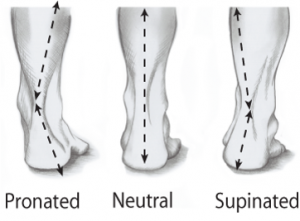Knee Solution Seminar Recap
On Tuesday and Wednesday this week Okanagan Peak Performance Inc presented the Knee Solution Seminar. Below is a recap of the main points from this presentation.
Why We Have Knee Problems In order to have the healthiest knees we need to make sure the joint sits in the proper place. And to do this properly we started at the ground looking at the foot. If the foot sits in a pronated position, with a collapsed arch, this will cause the knee to fall inward. And if we have a supinated foot, or high arch, the foot will roll out to the outside.
[caption id="attachment_5344" align="aligncenter" width="300"] Image showing a pronated, neutral and supinated foot position.
We ran through a couple of drills showing the attendees how to self-assess the positioning of the foot.
One drill involves placing the thumb and index finger on the same foot just below the malleolus. If your thumb and index finger are on the bumps on the sides of the ankle you're too high. Slide the fingers lower until them feel soft tissue.
From this position roll the ankle inward. On which finger do you feel more pressure? What happens to the arch? What happens to the knee?
Now repeat this drill and roll the ankle outward. Which finger feels more pressure? What happens to the arch? And where does the knee go?
The goal for this drill is find the position where there is 50-50 pressure on the thumb and index finger. Once the foot is set in this position the knee will line up optimally as well.
The other way we look at foot position was by considering the plantar surface (bottom of the foot). On the bottom of the foot imagine a triangle. And the three lines of this triangle are from the pad under the big toe to the pad under the pinkie toe to the pad under the heel.
These lines are also known as the anterior transverse arch, which connects the pad under the big toe with the pad under the pinkie toe, the medial longitudinal arch, which connects the pad under the big toe to the pad under the heel and lastly the lateral longitudinal arch, which connects the pad under the big toe to the pad under the heel.
[caption id="attachment_5346" align="aligncenter" width="209"] The longitudinal and transverse arches of the feet.
The longitudinal and transverse arches of the feet.
The goal is to have an equal distribution of weight on the three sides of the triangle.
If there is excessive pressure on the medial longitudinal arch, we pronate, lose our arch and the knee rolls inward.
If there is excessive pressure on the lateral longitudinal arch, we supinate, increase our arch and the knee rolls out.
If there is excessive pressure on the anterior transverse arch, we pitch forward, lose heel contact and the knee presses forward.
So why spend so much time on foot posture? Aren't we more concerned about the knee?
To be honest I wouldn't be surprised if someone were to get frustrated if they had a knee issue and the health professional they went to spent all their time examining the foot.
Here's why this makes sense.
The foot, like the knee, is a load bearing joint. In other words, the mass of the body is born by the joints that are contacting the ground or in direct vertical alignment with one of those joints. When the foot contacts the ground the pressure is felt by the foot, ankle, knee, hip...and all the joints in vertical alignment of these. The shoulders for example don't contact the ground and are on the edge of the trunk. So jumping and landing on a box isn't as stressful on the shoulders as it would be on the low back.
To make this point further imagine a toddler building a tower out of blocks. Oftentimes the goal is to make the tower as tall as possible. However if the first few blocks aren't perfectly aligned the error is magnified further up the tower to the point where the tower will eventually topple over.
[caption id="attachment_5345" align="aligncenter" width="300"] To go as high as possible, lower blocks (joints) must be perfectly aligned. Small errors at the bottom are magnified at the top.
To go as high as possible, lower blocks (joints) must be perfectly aligned. Small errors at the bottom are magnified at the top.
In the same way if our feet and ankles aren't optimally aligned this will lead to stress on the joints higher up the kinetic chain. Hint...if you have chronic low back pain do the tests described above for the feet and see if this helps provide some relief...you're welcome :)
This is just a brief snippet of what we covered during the Knee Solution Seminar. We also went over how one pound of additional mass can add 4,800 pounds to the joint for every mile walked.
We showed how setting proper alignment of the low back and pelvis led to proper alignment at the feet.
We spent a considerable amount of time at looking at why female athletes are at a higher risk for knee, specifically ACL, injuries than males.
We showed evidence i.e. peer-reviewed journal articles, on how fatigue, concussions and a weak core increase the chance of knee injuries. Lastly, we touched on what safe, effective and efficient knee training program looks like.
At the end there was an offer made to the attendees for one month of coaching to address their knee pain. If you would like to find out if you would be a good fit for our Knee Solution Program give us a call at (250) 212-2972.
When you subscribe to the blog, we will send you an e-mail when there are new updates on the site so you wouldn't miss them.

Comments